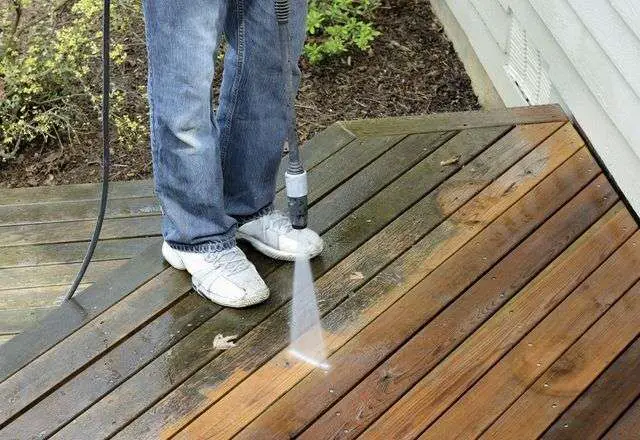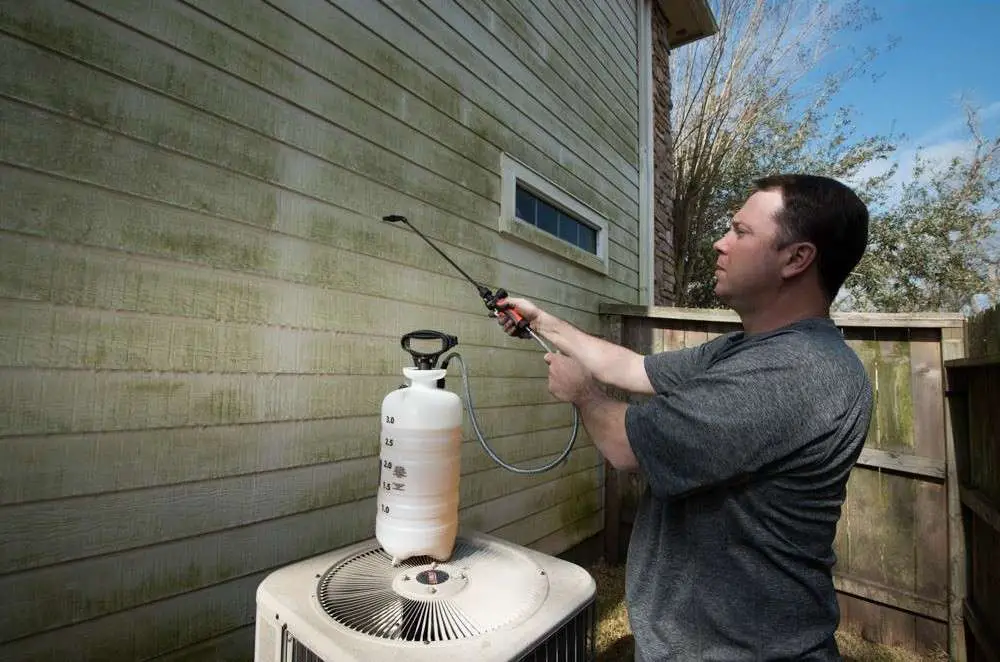Cleaning up black mold can be difficult enough, but cleaning it from wooden surfaces can be even more of a nightmare! Especially if the infestation is severe enough, you might be in for a wild couple of days.
The first key thing to notice is that black mold requires more moisture than other types of mold in order to grow. This makes it more likely to appear in heavily damp places and after unique situations like a flooding or an intense water leak. And if this has happened on a wooden surface, then chances are that the wood itself is compromised even just by the water, let alone by the mold itself.

In any such situation, the first advice that we hate to give but nevertheless have to is – consider throwing away the wooden material. We know it might be a favorite piece of furniture or a particularly useful wooden kitchen cabinet, but cleaning black mold from it might be more trouble than it is worth.
And we are not telling you this just because “black mold is toxic, throw away the contaminated stuff before you get sick and die!”, no don’t worry. We are not trying to exaggerate anything. Black mold is not always toxic and is not the only type of mold that can be toxic – all the horror surrounding black mold is less due to its toxicity and has more to do with a mass media craze that happened in the 90s.
In reality, black mold can be about as harmful as most other types of mold. However, it is more frequently met in homes and it can be a bit harder to deal with. Since black mold needs extra moisture to grow, it tends to grow inwards into the material. A lot of other types of mold spread only on the surface area of the material and are eager to spread their spores into the air. Black mold has slightly deeper roots than most of its brethren, which can be a pain to deal with, especially in porous surfaces like wood and timber.
Add to all that the fact that most good and powerful mold cleaning solutions are actually corrosive to wood and tend to destroy its surface, and the whole ordeal starts to feel a tad pointless.
So, unless you really want to save the wooden furniture for some sentimental or very practical reason – we’d advise you to consider disposing of it and replacing it with a new piece.
What If A Moldy Piece Of Timber Furniture Is Just Too Important To Throw Away? What Do You Do Then?
Well, as we know, getting rid of mold is a step-by-step process. And when it comes to wood, most of the steps are more or less the same, only more complicated. What are some of the factors that make cleaning wood harder, and are there some that actually make it easier?
- As a porous surface, wood is harder to clean for several reasons.
- First off, as a porous surface wood allows the mold to stem its roots deeper under the surface, making removing it even harder without harming the surface. Mold feeds on organic materials that are high on cellulose and that can pretty much be used as a definition of wood – “an organic material that is high on cellulose”. This is particularly true for black mold since it tends to let its roots go significantly deeper than other types of mold and since wood tends to retain moisture and dampness in it. - - Secondly, most of the powerful mold cleaning solutions have bleach-based formulas or ammonia-based formulas which can be highly destructive towards all porous surfaces, including (and especially) wood. This means that if you want to save the timber furniture you might have a harder time finding a suitable mold cleaner, as well as a harder time applying it and scrubbing the surface.
- - Lastly, because wood is a porous surface, it makes the extensive cleaning of mold much harder – the mold has more opportunities to leave some small traces in the wood than it has on non-porous surfaces like bathroom tiles. And if you fail to remove every single last spot or dot of mold from the surface, you might as well throw it away altogether, because in a short while the mold infestation will just grow back.
- There is also one thing that makes cleaning wood easier than other surfaces. Not easy, but a bit easier – if we are talking about wood, we are likely talking about furniture, a door, wainscoting or a cabinet. And these are things that can be relatively easily be moved outside of your home for the cleaning process. This may seem insignificant, but it is actually far from it.
- One of the key problems most people fail to consider when cleaning mold is isolating the contaminated area from the rest of their home. This is bad because when the mold is being removed or disturbed, it immediately releases its spores into the air. So, if you haven’t sealed off the air vents, and the doors and windows to the rest of the house, you face the great risk of several new black mold infestations appearing in other parts of your home very soon after cleaning the initial spot.
- When it comes to cleaning wooden furniture, however, you can usually just take it outside and away from your home and clean it there. This makes the future contaminations in your home much less likely. Plus, if it is sunny outside this will greatly help with drying off the wood, as well as tormenting the mold with ultraviolet light, which mold can’t stand.

So, if we are clear on the specifics that wood brings to the mold-cleaning equation, let’s go over the step-by-step process of cleaning mold from it:
- Choose the right cleaning solution. With non-porous surfaces this is a much easier process because you can afford to just go for the strongest mold-killing product you can find and not care about most of the consequences it can have on the contaminated surface. This is not the case if you want to save your wooden furniture. So, stick to more mild solutions. Consider things such as:
- A mix of household detergent and water.
- A mild and wood-friendly commercial mold cleaning product.
- Distilled white vinegar (it is very effective but the smell can be tricky to get rid of from wood).
- A baking soda and detergent solution (1/2 cup of baking soda, 1 cup of water and 1 table spoon of detergent).
- A borax solution (1 part borax and 16 parts water)
(Note: Never mix things with anything other than water. Mixing different disinfectants into one can cause unexpected and dangerous chemical reactions. The best example is mixing bleach with ammonia with can be extremely toxic and outright dangerous to your health.)
- Protect yourself while cleaning. This is an often missed step when dealing with mold. Most people view this as unnecessary, but even if the mold isn’t releasing mycotoxins, inhaling or ingesting it can be quite dangerous to your health (let alone disgusting and unpleasant). Plus, a lot of mold cleaning products can be dangerous to the touch, even the ones that are mild enough to use on wood.
- So, things like eye goggles, a dust filter mask, as well as rubber or latex gloves are highly recommended when cleaning any type of mold from any type of surface. Especially if you are worried about your clothes or if you don’t want to spread the contamination into the rest of your home, you might want to wear a full-body protection suit.
- Take the contaminated wooden surface outside of your home if possible. This will protect your home from airborne mold contamination, as well as help combat the mold by exposing it to sunlight and wind.
- Scrub and clean the contamination with a brush or a piece of cloth and with soap water. This will remove the upper layers of the mold and expose its roots for your cleaning solution to deal with. Remember to use soapy water – don’t scrub dry mold since the airborne spores will be release in much greater quantities and be much more dangerous.
- Apply the cleaning solution in the manner described on it.
- Wait as much as it is needed (if any) and then scrub or rinse the area if it is specified to do so.
- Let the contaminated area dry off completely. If needed use a vacuum cleaner or any other device to completely dry off the wood. Wood tends to hold water so you need to be thorough or you’ll face a second mold infestation pretty soon.
- If needed, repair the damaged wooden surface in whichever way you prefer. You may apply some mold sealant underneath, to make sure that if there are any small patches of mold left, they won’t spread. A high quality mold resistant paint is perfect for this task.

Conclusion
And that’s more or less it. We warned you
it’s a pain to clean mold from wood. It’s not always easy but there are steps you can take to make the process easier.Whether you decide to paint over the mold spot or scrub it away with a mold remover, you'll prolong the life of your timber surfaces and keep them mold free for longer.
Resources
